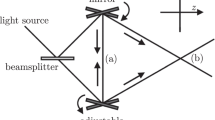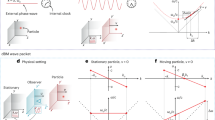Summary
The paper deals with moving interferometer experiments. The analysis of these experiments is given. The possibility of both the longitudinal and transversal contraction of lengths, characterized by the factorsΦ andΨ, respectively, is considered. It is shown that generallyΨ=(1−v 2/c 2)1/2+γ. The relationΦ=√1−(v 2/c 2 Ψ is verified. The Palacios theory explains the moving interferometer experiments in the physically simplest possible way by takingγ=0. In the Lorentz theory the nonexistence of the transversal contraction is supposed,i.e. γ=−1/2. However, then it is necessary to consider the dependence of the time interval Δt* on the velocityv, Δt* being the time required for the light beam to travel through the interferometrical layer. It is demonstrated that both theories mentioned give fully consistent explanations of the moving interferometer experiments.
Riassunto
In questo articolo si trattano gli esperimenti con l’interferometro mobile. Si esegue l’analisi di questi esperimenti. Si considera la possibilità che le lunghezze si contraggano con fattoriΦ eΨ. Si mostra che generalmenteΨ=(1−v 2/c 2)1/2+γ. Si verifica la relazioneΦ=√1−(v 2/c 2 Ψ. La teoria di Palacios spiega gli esperimenti con l’interferometro mobile nel modo fisicamente più semplice assumendoγ=0. Nella teoria di Lorentz si presuppone che la contrazione trasversale non esista, cioèγ=−1/2. Comunque in tal caso è necessario tener conto della dipendenza dell’intervallo di tempo Δt* dalla velocitàv, Δt* essendo il tempo necessario perché il fascio luminoso attraversi lo strato interferometrico. Si dimostra che entrambe le teorie succitate danno spiegazioni completamente coerenti degli esperimenti con l’interferometro mobile.
Similar content being viewed by others
References
M. Podlaha andE. Navrátil:Rev. de la Real Acad. Ciencias Exactas de Madrid,61, 555 (1967).
J. Palacios:Rev. de la Real Acad. Ciencias Exactas de Madrid,55, 201 (1961).
J. Romain:Nuovo Cimento,30, 1254 (1963).
J. Palacios:Nuovo Cimento,43 A, 413 (1966).
T. Alväger, J. M. Bailey, J. M. Farley, J. Kjellman andJ. Wallin:Ark. Fys.,31, 145 (1966).
W. D. Schmidt-Ott:Phys. Bl.,24, 150 (1968).
A. Einstein:Ann. der Phys.,17, 891 (1905).
M. Podlaha andE. Navrátil:Acta Phys. Austriaca,24, 99 (1966).
H. A. Lorentz:The Theory of Electrons (Leipzig, 1916).
Author information
Authors and Affiliations
Rights and permissions
About this article
Cite this article
Podlaha, M. Lorentz theory, palacios theory and interferometrical experiments. Nuovo Cimento B (1965-1970) 64, 181–187 (1969). https://doi.org/10.1007/BF02710291
Received:
Revised:
Published:
Issue Date:
DOI: https://doi.org/10.1007/BF02710291




